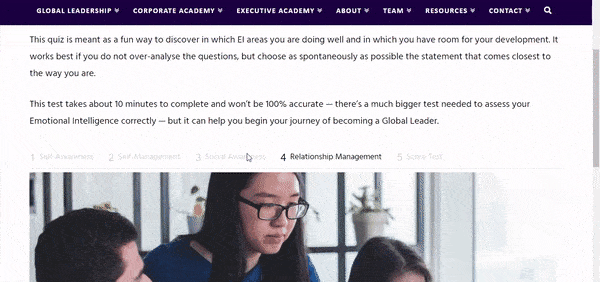Effective Communication — the key to success for any business, whether global or local. As a global leader, getting your employees to communicate effectively across cultures can be one of your greatest challenges.
Having said that, here are four tips you can use to keep misunderstandings and mishaps at a minimum and productivity at an all-time high.
Contents
1. Cultivate a Culture of Openness
Promoting open communication across the business generally needs to be a foundational company value charter that is embodied throughout all levels of the company.
So how do you cultivate a culture of openness?
Have a solid feedback culture
If the company doesn’t have a solid feedback culture, then there will be an underlying sense of intimidation around constructive criticism. People become too frightened to challenge the status quo and take all the ideas that would have propelled the business performance elsewhere. Such a waste.
A good way to do this is to have an online social forum which can be used to present ideas. Employees can put an idea forward and the company or their department can comment on how they might contribute to making the idea come to life.
For example:
Carrie Morris — Data Analyst (London) writes, “Hey guys. I was travelling to work recently and I realised that there’s a homeless shelter right on our doorstep. I got talking to one of the employees there and they said they could really do with finding people to help with workshops that will help the homeless learn new skills. Is there anyone who could help with that?”
Diane Corden — IT Manager (London) answers “Hey Carrie, I think a couple of us from IT could run a computer workshop teaching basic computer skills once a fortnight @Josh @Tejan @Julia what do you guys think?”
Josh — IT Consultant — is also on board: @Diane — “we’d definitely be up for that.”
Alex Myers — Marketing Strategist (New York): “Happy to put together an awesome powerpoint presentation and design some workbooks for the people in the class!”
Angela Reynolds — EMEA Talent Acquisition Director (Paris): “I’ll be in your neck of the woods for the next six months. Would love to run an interview skills workshop!”
Carrie Morris — Data Analyst: “Overwhelmed guys, thanks so much! Will send over a some times for a meeting to discuss! #bestcompanyever”
Give it a try and see what you think. The idea is to create plenty of opportunities in company life for people to share their views, ideas and passions. The sky is the limit!

Lead by example
Top-level management has a responsibility to engage in initiatives and projects that go across departments and require wider input.
Make a huge deal when a project has been successful because of great collaboration, and make it visual. Pictures around the office, email bulletins, award ceremonies… do what you can to make people aware of the achievements and victories that come via effective communication.
Have mechanisms that keep communication channels open. For larger companies with thousands of employees, there needs to be some gatekeeping. But on the whole, employees should hear from you on a regular basis and see you physically when possible. Keep communication personal and don’t lock yourself up in a ‘high tower’ where your employees cannot get word to you about the state of company affairs.
2. Utilise Technology
Is it advisable to let employees use Facebook, Instagram and Twitter during work hours?
Probably not.
But there are some absolutely amazing work-based communication apps that make effective communication a breeze. If you know that employees will benefit from seeing each other and hearing each other, don’t be afraid to utilise video-calling or voice calling to get your team communicating regularly. This is particularly good if your team members are remote.
Informal communication channels will help your team relax and feel better about talking to each other. They’ll get things done a lot quicker and it’s a great way for people to express themselves a little. Also, employees are more likely to use direct, simple language that communicates the message in the most efficient way. This is especially great if people get a little worried about understanding accents, for example.
Technology helps to level the cultural playing field in a really easy way. It brings whole teams together into a common communication channel and breaks down any boundaries around physical locations, cultures and company positions.
Emojis even have a variety of skin tones now and ways to express cultural differences in a fun upbeat kind of way. So really make the most of the great tech that’s out there as part of an effective communication strategy.
This brings us nicely to the next point.

3. Encourage the Use of Universal Language
Whatever the main language in the company, be sure that employees use a universal version of it. The English language, for example, has an infinite number of variations and expressions. Local phrases which make sense in America, may not make sense in India, even though everybody is speaking English.
Encourage your employees to use language as simply and as effectively as possible. Elegance has its place, but most of us are not actually writers of beautiful literature. Use a working language that can be understood by everyone.
The best way to test this is to send out a message to be proofread by somebody who doesn’t speak the company language as a first language. If they can interpret correctly what has been said, it’s a good message. If it confuses them, go back to the drawing board until you’ve settled on communication that’s much clearer.
4. Encourage Empathy
Empathy is really about having the capacity to understand the perspectives of the people around you. It has a huge part to play because learning about people fuels empathy.
Bringing loads of cultures together really is a wonderful opportunity. But global leaders should encourage their employees to learn enough about the culture of other team members so that everybody knows how to get the best out of one another.
The behaviour of people is often made up of a mixture of choice, customs they’ve grown up with, and a whole variety of creative and emotional expression. Different personalities will respond to the same conversation in a myriad of ways.
This does bring out different points of view, which is brilliant for a business. But the other side of the coin becomes apparent during that exchange of views; the door is open to conflict, misunderstandings and potential friction within teams as passions run high.
To temper that, there needs to be a mechanism to cool the flames and reduce the feeling of offence within the team. If you would love to see real collaboration, encourage your employees to be proactive in learning about their teammates.
Why?
When your team members learn about each other, they’ll be better able to gauge the best way to approach one another about work tasks. The overly polite, super quiet teammate will know that with their super direct, lively colleague, they’ll need to take a different approach to get the results that they need.
This does not mean that team members should abandon the principles of respecting one another as fellow human beings. This is to say that a team with high levels of empathy will experience lower levels of tension.

Here’s a great tip to do this… prepare for the lightbulb moment.
Get employees to sit down and write a short personal guide telling their work colleagues how to get the best out of them. Everyone shares them in a meeting and gets a copy to refer to later. At first, it feels a bit awkward but it eventually becomes second nature to think about how your teammate is going to receive your communication style.
This 30-minute exercise will relieve anxiety and tension dramatically and you’ll see team members come out of their shells and give their best work. It will also streamline the journey to effective communication across cultures because the employees give one another the tools to understanding their work style and their preferred communication style.
There are no offensive stereotypes, guesswork or catastrophic assumptions that make HR want to leave the building. You just get an encyclopedia of how to get the best out of one another. It’s a lot cheaper than hiring a corporate team-building coach later on down the line when everybody dislikes everybody and the company is suffering for it.
If you encourage this soft skill as a global leader, you inadvertently develop your employees to be some of the most valuable people, because you can send them anywhere and they will thrive. If you can get your employees to understand that it’s a skill to not try to force your way on others, they’ll stop and think about the language, tone and manner they use to convey opinions, instructions and ways to solve problems.
A good tool to see where you and your team stands is the Emotional Intelligence Test. After a couple of minutes you know exactly how skilled you are in terms of self-awareness, self-management, social awareness and relationship management. Take it here:
In short, there are four tips you can take away to ensure effective communication throughout the company.
- Create that culture of openness — that has to be a foundational principle woven through organizational culture where people feel like they can talk to colleagues across all levels of the business.
- Utilise Technology — if the team is global in a geographical sense as well as a cultural sense, encourage people to use video-calling, voice calls and messenger apps to get stuff done.
- Use Universal language — encourage native company language speakers to be mindful that they might be misunderstood using local phrases not known in other regions of the world. Keep communication simple and easy to understand.
- Encourage Empathy — possibly the most important point. Encourage employees to be proactive in understanding one another.
An attitude of respect breeds a culture of appreciation. As a global leader, this sort of working environment will produce employees you’ll never cease to be proud of.
And if you want to learn more about global leadership…


